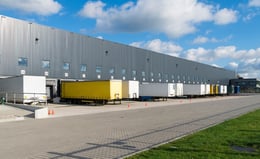5 Tips for Improved Production Planning
Brian Hoey - May 09, 2019

The best laid plans of mice and men often go awry—and nowhere is that more true in the worlds of manufacturing and supply chain management. Sometimes it seems like even the most visible and adaptable supply stream is always one disruption away from chaos. For production planners in particular, you’re constantly battling the risk that new, unexpected orders will come in and you won’t know how to slot them into your existing flows, or that a machine on your production floor will break down and bring your whole operation grinding to a halt. To some extent, occurrences like these are just a fact of life. But that doesn’t mean planners can’t work to prevent them, just as it doesn’t mean that planners can’t work to gain more value from the processes that are already working smoothly.
So, without further ado, let’s look at a few strategies planners and supply chain managers can employ for improving their production plans, both in terms of resilience to disruption and overall efficiency.
1. Improve Your Forecasts
Any production plan should begin with a few questions: what products will you need to produce to meet demand? What quantity will you need to produce? And what materials will you need in order to achieve that quantity? Because sourcing for many materials requires a longer lead time than the typical customer order, most manufacturing businesses have to rely on past demand to estimate their sourcing needs in advance. While the past can be instructive, it’s also a necessarily limited guidepost when it comes to predicting future market conditions, as it fundamentally can’t account for new and emerging conditions. Since your forecasts determine how you spend your money, and the accuracy of your forecasts in turn determine how effectively you spend that money, it stands to reason that investing in improvements to your forecasting methods should yield a positive ROI. If you already have digital data streams coming in from your production workflows and broader market conditions, it might be worthwhile to consider using advanced analytics or machine learning solutions to derive your forecasts digitally. This way, you’re not tethered to the logic of past data, and can begin to better align expectations and reality by utilizing more dynamic demand forecasting.
2. Document Your Capacity
One of the keys to production planning is to reduce your amount of unused production capacity. If at all possible, you want to avoid situations where machines or humans are sitting idle for long stretches of time. Naturally, it’s not feasible (or even desirable) to have every resource in constant operation, but for the most part protracted downtime is inefficient and costly. How can planners prevent a loss of value of this kind from happening? Well, for starters, it’s crucial to figure out what your production capacity actually is. This might sound basic, but it can be deceptively complex. Why? Because different products will take different journeys from order creation to the factory floor to the warehouse. In a job shop environment, for instance, there’s no set order of operations, which means that different production flows for different products have to be balanced against one another in a fairly complex way in order to determine maximum capacity levels. For this reason, it’s crucial to find a way to map out your production processes so that you can determine your actual maximum capacity. This can be as simple as identifying and timing your bottleneck processes, or as sophisticated as digitally mapping your factory floor to train advanced analytics algorithms on your operations.
3. Root Out Planning Silos
In the first two tips, we focused on ways to create parameters by which to plan more effectively—both in terms of maximizing capacity and matching expectation to reality. For the next couple of tips, we’ll shift the focus towards ways to make sure that your plans are actually carried out in an efficient manner, with as little time and value as possible lost to disruption. To that end, your first and perhaps most important task is to take whatever actions you can to eliminate planning silos within your operation. It’s not uncommon even in modern manufacturing to find that procurement processes, for instance, are separated from production planning—meaning that even if your forecasts are accurate enough to empower optimal production plans, you might easily find that you don’t have the necessary materials on hand to carry out your processes as planned. By the same token, you could find that machine operators didn’t have access to a particular contingency plan to be implemented in case of a particular set of events, and were thus left wondering what to do when those events emerged. Of course, breaking down silos is easier said than done, but a good starting place is to increase operational visibility. This might involve adopting an IT system (or connecting your existing IT infrastructure) in such a way as to make data more available across the board, or implementing IoT devices and other digital technology to ensure that there’s a digital record of all the data you’re collecting.
4. Utilize Real-time Monitoring
Speaking of IoT devices: by implementing these sorts of smart, connected sensors into your production chain, you can empower real-time monitoring of production processes. In this way, you can track the progress of each product through the production line and monitor machine usage to make sure that everything is operating smoothly and that there won’t be any slowdowns that will affect your final output. In an Industry 4.0 environment, this type of tracking can even be automated such that planners receive alerts whenever something on the factory floor deviates from the plan. This can help you to keep plans on track even as they’re being put into practice.
5. Integrate With Transport Logistics Processes
Okay, so let’s say your expectations are aligned with reality, you understand your production capacity and can maximize it accordingly, and you’ve done a good job of staving off disruptions. What happens next? Well, ideally, your products make their way from the factory floor to a warehouse and then on to your customers. Unfortunately, this isn’t always exactly what happens. No matter how perfectly conceived and executed your production plan might be, it’s all for naught if you aren’t able to move the goods off the production line in an efficient manner. For this reason, it’s crucial that all of the principles we touted above (like visibility, integration, and the reduction of silos) be applied not just within your production flows, but to the supply chain more broadly. In this way, you can extend your smart, optimized processes beyond the factory floor and out into the world.
If you want to learn more get your Guide to Production Planning
In this Guide you will learn:
-
How to build resilience
-
How to increase efficiency
-
How to use integrated APS planning services for production planning
-
What must-have features of an APS solution you need
-
Which KPI’s you can expect
LATEST POSTS
- Understand Circular Economy in The Manufacturing Industry
- How Can Industry 4.0 IT Integration Be Achieved Smoothly?
- The Significance of Order Sequencing in Discrete Manufacturing
- How to improve your Supply Chain Management: The Power of Control Towers
- Optimizing Human Resource Scheduling in Manufacturing: A Technological Approach



